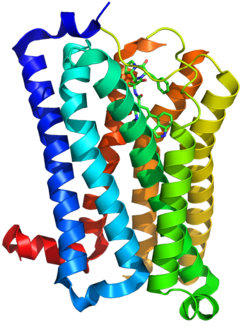5-HT1B receptor
| HTR1B |
 |
|
|
| Identifiers |
| Aliases |
HTR1B, 5-HT1B, 5-HT1DB, HTR1D2, HTR1DB, S12, 5-HT-1B, 5-HT-1D-beta, 5-hydroxytryptamine receptor 1B |
| External IDs |
MGI: 96274 HomoloGene: 669 GeneCards: HTR1B |
|
| Targeted by Drug |
|
frovatriptan, 1-naphthylpiperazine, 2-methyl-5-HT, 5-carboxamidotryptamine, pathogen, 5-methoxytryptamine, 5-(nonyloxy)-tryptamine, (+/-)-8-hydroxy-2-(di-N-propylamino)tetralin, alniditan, aripiprazole, cabergoline, cgs 12066b-parent, clozapine, CP-122288, CP94253, dihydroergotamine, donitriptan, eletriptan, lysergol, olanzapine, oxymetazoline, pergolide, ru-24969, 1-(3-trifluoromethylphenyl)piperazine, tryptamine, xanomeline, ziprasidone, brl-15572, bromocriptine, gr-127935, lisuride, naratriptan, rizatriptan, roxindole, sb-216641, sumatriptan, terguride, vortioxetine, zolmitriptan, ketanserin, metergoline, methysergide, ocaperidone, pipamperone, α-yohimbine, risperidone, ritanserin, sertindole, yohimbine, zotepine, metitepine, SB236057
|
|
|
|
RNA expression pattern |
 |
| More reference expression data |
| Orthologs |
| Species |
Human |
Mouse |
| Entrez |
|
|
| Ensembl |
|
|
| UniProt |
|
|
| RefSeq (mRNA) |
|
|
| RefSeq (protein) |
|
|
| Location (UCSC) |
Chr 6: 77.46 – 77.46 Mb |
Chr 9: 81.63 – 81.63 Mb |
|
PubMed search |
|
|
|
|
|
4IAQ, 4IAR
3351
15551
ENSG00000135312
ENSMUSG00000049511
P28222
P28334
NM_000863
NM_010482
NP_000854
NP_034612.1
NP_034612
5-hydroxytryptamine receptor 1B also known as the 5-HT1B receptor is a protein that in humans is encoded by the HTR1B gene. The 5-HT1B receptor is a 5-HT receptor subtype.
5-HT1B receptors are widely distributed throughout the CNS with the highest concentrations found in the frontal cortex, basal ganglia, striatum, and the hippocampus. The function of the 5-HT1B receptor differs depending upon its location. In the frontal cortex, it is believed to act as a postsynaptic receptor inhibiting the release of dopamine. In the basal ganglia and the striatum, evidence suggests 5-HT signaling acts on an autoreceptor, inhibiting the release of serotonin and decreasing glutamatergic transmission by reducing miniature excitatory postsynaptic potential (mEPSP) frequency, respectively. In the hippocampus, a recent study has demonstrated that activation of postsynaptic 5-HT1Bheteroreceptors produces a facilitation in excitatory synaptic transmission which is altered in depression. When the expression of 5-HT1B in human cortex was traced throughout life, significant changes during adolescence were observed, in a way that is strongly correlated with the expression of 5-HT1E.
...
Wikipedia


